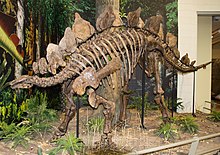Portal:Dinosaurs
IntroductionDinosaurs are a diverse group of reptiles of the clade Dinosauria. They first appeared during the Triassic period, between 243 and 233.23 million years ago (mya), although the exact origin and timing of the evolution of dinosaurs is a subject of active research. They became the dominant terrestrial vertebrates after the Triassic–Jurassic extinction event 201.3 mya and their dominance continued throughout the Jurassic and Cretaceous periods. The fossil record shows that birds are feathered dinosaurs, having evolved from earlier theropods during the Late Jurassic epoch, and are the only dinosaur lineage known to have survived the Cretaceous–Paleogene extinction event approximately 66 mya. Dinosaurs can therefore be divided into avian dinosaurs—birds—and the extinct non-avian dinosaurs, which are all dinosaurs other than birds. Dinosaurs are varied from taxonomic, morphological and ecological standpoints. Birds, at over 11,000 living species, are among the most diverse groups of vertebrates. Using fossil evidence, paleontologists have identified over 900 distinct genera and more than 1,000 different species of non-avian dinosaurs. Dinosaurs are represented on every continent by both extant species (birds) and fossil remains. Through the first half of the 20th century, before birds were recognized as dinosaurs, most of the scientific community believed dinosaurs to have been sluggish and cold-blooded. Most research conducted since the 1970s, however, has indicated that dinosaurs were active animals with elevated metabolisms and numerous adaptations for social interaction. Some were herbivorous, others carnivorous. Evidence suggests that all dinosaurs were egg-laying, and that nest-building was a trait shared by many dinosaurs, both avian and non-avian. (Full article...) Selected article
Velociraptor (meaning 'swift thief') was a genus of dromaeosaurid theropod dinosaur that existed approximately 83 to 70 million years ago during the later part of the Cretaceous Period. There is only one currently recognized species, V. mongoliensis, although others have been assigned in the past. Fossils of this species have been found in central Asia, from both Inner and Outer Mongolia.
Smaller than other dromaeosaurids like Deinonychus and Achillobator, the turkey-sized Velociraptor nevertheless shared many of the same anatomical features. It was a bipedal carnivore with a long, stiffened tail and had an enlarged, sickle-shaped claw on each hindfoot, which is thought to have been used to kill its prey. Velociraptor can be distinguished from other dromaeosaurids by its long and low skull, with an upturned snout. Due in large part to its prominent role in Michael Crichton's novel Jurassic Park and the subsequent motion picture series, Velociraptor (commonly shortened to 'raptor') is one of the dinosaur genera most familiar to the general public. It is also well-known to paleontologists, with over a dozen recovered fossil skeletons — the most of any dromaeosaurid. One particularly famous specimen shows a Velociraptor locked in combat with a Protoceratops. (see more...) TopicsSubcategoriesSelected image
Photo credit: User:Axel.Mauruszat Did you know...
Things you can do
Proposed deletions
Peer reviews
Articles to be merged
Articles to be split
Related content
Associated WikimediaThe following Wikimedia Foundation sister projects provide more on this subject:
Discover Wikipedia using portals |





























